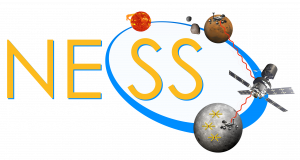How do radio telescopes work?
A simple radio telescope is likely quite familiar: it is a device to capture radio waves, just like a radio antenna or a satellite dish. As with normal telescopes, bigger radio telescopes can collect more light so are more useful for astronomers (and for all of us trying to listen to distant radio transmitters!). However, because radio waves oscillate across relatively large distances (in the case of the measured spin-flip background, across distances a few meters across), radio telescopes must be very large. In practice, making a single radio telescope able to measure the variations in the spin-flip background is impractical. Fortunately, astronomers have learned to combine the signals from different antennae using a technique called interferometry. This can even allow the signals from several hundred dishes to be combined into one measurement, as the Hydrogen Epoch of Reionization Array (or HERA, which you can learn more about below) is doing in South Africa to measure the spin-flip background.
Image: Parkes telescope in Australia, part of the Commonwealth Scientific and Industrial Research Organization.
Credit: CSIRO/Shaun Amy
Why is the spin-flip background so hard to observe?
There are three principal challenges to observing the spin-flip background, all arising from its low frequencies at Earth. First, the signal appears in the same radio frequency band as radio broadcasts, TV transmissions, and many communications systems. These are far, far stronger than the spin-flip background. Second, the Milky Way galaxy “glows” at these frequencies thanks to light generated by cosmic rays streaming through the Galaxy. This unavoidable foreground is roughly 10,000 times stronger than the signal from the Cosmic Dawn! Third, the Earth’s ionosphere affects radio waves as they travel through it. The spin-flip background from the Cosmic Dawn is distorted by the ionosphere, while that from earlier times like the Dark Ages can be blocked completely.
Image: 1 Aug. 1971, Astronaut David R. Scott, Apollo 15 commander, is seen carrying the Apollo Lunar Surface Drill (ALSD) during the second lunar surface extravehicular activity (EVA), an example of TV broadcast interference for radio observations.
Credit: JSC
How can astronomers overcome these challenges?
To decrease interference from our own transmitters, the simplest solution is to build the telescope in an isolated location – astronomers use radio telescopes in the Australian outback and in the desert of South Africa, for example. Alternatively, powerful computers can separate the contamination and allow measurements in the unaffected parts of the radio spectrum. Computers are also essential for tackling the other obstacles. For example, distortions from the ionosphere can be measured in real time and corrected with computers.
Image: HERA construction in South Africa
Credit: Dara Storer, HERA Construction Photo log
But the most challenging aspect is also unavoidable: the “foreground” from the Milky Way. This is so strong that the current generation of experiments cannot completely overcome the noise, and rather than make images of the sky, astronomers must measure statistics to compare with models. Even that is challenging, as the foregrounds themselves can contaminate statistical measurements as well.. Sifting through these statistics is the primary challenge for existing and future radio measurements of the Cosmic Dawn.
Image: The Two Micro All Sky Survey
Credit: JPL, M.F. Skrutskie UMass, 2MASS, J.M. Carpenter Caltech, R. Hurt IPAC/Caltech
What have we learned so far?
Although the first efforts to observe the spin-flip background from cosmic structures date back more than 50 years, only in the past decade has our understanding of the signal and computing power advanced far enough to make the observations practical. Despite intense (and ongoing!) efforts, only one experiment has made a tentative detection of the signal. In the winter of 2018, the Experiment to Detect the Global EoR Signature (EDGES) collaboration presented the first measurement of an “all-sky” spin-flip background. The extreme difficulty of the data analysis means that the measurement needs confirmation, but if that occurs, the surprising nature of the signal means that there is much to be learned about the Cosmic Dawn!
Image: EDGES in Western Australia
Credit: MRO, ASU, MIT
What does the future hold?
Several radio telescopes are trying to observe the spin-flip background now. Our team is involved with the Hydrogen Epoch of Reionization Array, or HERA, a large telescope dedicated to observing the Cosmic Dawn. It is now under construction in the Karoo desert of South Africa, and it will eventually be made of more than 300 antennae, each 14 meters across. The HERA collaboration and many others are continuing to improve their analysis procedures, and we hope to make measurements of the Cosmic Dawn in the next few years. Meanwhile, 'all-sky' experiments like EDGES are also continuing to make observations and test for systematic problems. As NASA returns to the Moon, it also offers an excellent platform for these observations, as described on the Lunar Radio Telescopes page.
Image: NASA’s New Horizons spacecraft on the Atlas V rocket after launch from Cape Canaveral Air Force Station in Florida.
Credit: NASA/Kim Shiflett


